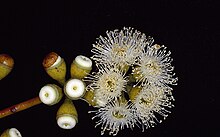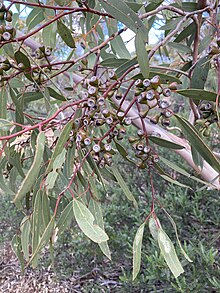| Dongara mallee | |
|---|---|

| |
| Habit near Warradarge | |
| Scientific classification | |
| Kingdom: | Plantae |
| Clade: | Tracheophytes |
| Clade: | Angiosperms |
| Clade: | Eudicots |
| Clade: | Rosids |
| Order: | Myrtales |
| Family: | Myrtaceae |
| Genus: | Eucalyptus |
| Species: | E. obtusiflora |
| Binomial name | |
| Eucalyptus obtusiflora DC. | |
| Synonyms | |
| |


Eucalyptus obtusiflora, commonly known as Dongara mallee, is a species of mallee that is endemic to Western Australia. It has smooth greyish or brownish bark that is often imperfectly shed, lance-shaped to curved adult leaves, flower buds usually in groups of seven or nine, creamy white flowers and cup-shaped, conical or barrel-shaped fruit.
Description
Eucalyptus obtusiflora is a mallee, sometimes a small tree, that typically grows to a height of 4–5 m (13–16 ft) and forms a lignotuber. It has smooth, greyish or brownish bark that is often imperfectly shed on the lower half of the stems. Young plants and coppice regrowth have greyish green, egg-shaped, sometimes glaucous leaves that are 40–80 mm (1.6–3.1 in) long and 25–40 mm (0.98–1.57 in) wide. Adult leaves are the same shade of dull, sometimes bluish green on both sides, lance-shaped to curved, 70–130 mm (2.8–5.1 in) long and 10–25 mm (0.39–0.98 in) wide, tapering to a petiole 12–25 mm (0.47–0.98 in) long. The flower buds are arranged in leaf axils, usually in groups of seven or nine, on an unbranched peduncle 5–20 mm (0.20–0.79 in) long, the individual buds on pedicels 2–10 mm (0.079–0.394 in) long. Mature buds are oval, cylindrical or spindle-shaped, 7–12 mm (0.28–0.47 in) long and 5–8 mm (0.20–0.31 in) wide with a rounded to flattened operculum. It blooms between January and May producing white or creamy white flowers. The fruit is a woody cup-shaped, conical or barrel-shaped capsule 7–12 mm (0.28–0.47 in) long and 7–10 mm (0.28–0.39 in) wide with the valves near rim level.
Taxonomy and naming
Eucalyptus obtusiflora was first formally described in 1828 by Augustin Pyramus de Candolle in his treatise, Prodromus Systematis Naturalis Regni Vegetabilis. The specific epithet (obtusiflora) is from the Latin obtusus meaning "obtuse" or "blunt" and -florus meaning "-flowered", referring to the bluntness of the operculum, although that structure is not always blunt.
The name Eucalyptus obtusiflora has been applied to both a Western Australian species and to a species known in New South Wales as Port Jackson mallee, as for example in Flora of Australia. According to Dean Nicolle, Alex George and Peter G. Wilson, this situation arose because of confusion about the type material. The eastern Australian species is now considered to be Eucalyptus obstans, recognised by the Australian Plant Census (APC), as a synonym of E. burgessiana.
Three subspecies are recognised by the APC:
- Eucalyptus obtusiflora subsp. cowcowensis L.A.S.Johnson & K.D.Hill;
- Eucalyptus obtusiflora subsp. dongarraensis (Maiden & Blakely) L.A.S.Johnson & K.D.Hill;
- Eucalyptus obtusiflora DC. subsp. obtusiflora.
Distribution and habitat
The Dongara mallee is found in interdunal hollows between Jurien Bay and Moora in the south of its range to Gnaraloo in the north, and inland to Wubin, Wyalkatchem and Corrigin. It grows in sandy-loam soils.
See also
References
- ^ "Eucalyptus obtusiflora". Australian Plant Census. Retrieved 19 November 2019.
- ^ "Eucalyptus obtusiflora". FloraBase. Western Australian Government Department of Biodiversity, Conservation and Attractions.
- ^ "Eucalyptus obtusiflora". Euclid: Centre for Australian National Biodiversity Research. Retrieved 31 May 2020.
- "Eucalyptus obtusiflora". APNI. Retrieved 19 November 2019.
- de Candolle, Augustin Pyramus (1828). Prodromus systematis naturalis regni vegetabilis, sive, Enumeratio contracta ordinum generum specierumque plantarum huc usque cognitarium, juxta methodi naturalis, normas digesta. Parisii :Sumptibus Sociorum Treuttel et Würtz. p. 220. Retrieved 19 November 2019.
- Francis Aubie Sharr (2019). Western Australian Plant Names and their Meanings. Kardinya, Western Australia: Four Gables Press. p. 263. ISBN 9780958034180.
- Chippendale, George M. "Eucalyptus obtusiflora". Flora of Australia. Australian Biological Resources Study, Department of the Environment and Energy, Canberra. Retrieved 19 November 2019.
- Nicolle, Dean; George, Alex S.; Wilson, Peter G. (2019). "Application of the name Eucalyptus obtusiflora DC. (Myrtaceae)". Telopea. 22: 61–66. doi:10.7751/telopea13362.
- "Eucalyptus burgessiana". Australian Plant Census. Retrieved 19 November 2019.
- "Eucalyptus obtusiflora subsp. cowcowensis". Australian Plant Census. Retrieved 19 November 2019.
- "Eucalyptus obtusiflora subsp. dongarraensis". Australian Plant Census. Retrieved 19 November 2019.
- "Eucalyptus obtusiflora subsp. obtusiflora<". Australian Plant Census. Retrieved 19 November 2019.